1. matplotlib的绘图样式(style)
在matplotlib中,要想设置绘制样式,最简单的方法是在绘制元素时单独设置样式。
但是有时候,当用户在做专题报告时,往往会希望保持整体风格的统一而不用对每张图一张张修改,因此matplotlib库还提供了四种批量修改全局样式的方式
1.1 matplotlib预先定义样式
matplotlib贴心地提供了许多内置的样式供用户使用,使用方法很简单,只需在python脚本的最开始输入想使用style的名称即可调用,尝试调用不同内置样式,比较区别
import matplotlib as mplimport matplotlib.pyplot as pltimport numpy as np
plt.style.use('default')plt.plot([1,2,3,4],[2,3,4,5])plt.show()
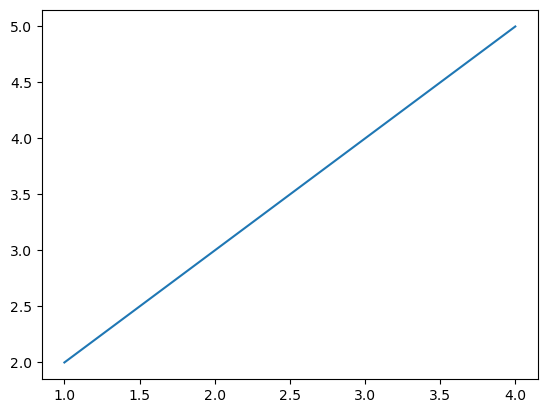
plt.style.use('ggplot')plt.plot([1,2,3,4],[2,3,4,5])plt.show()
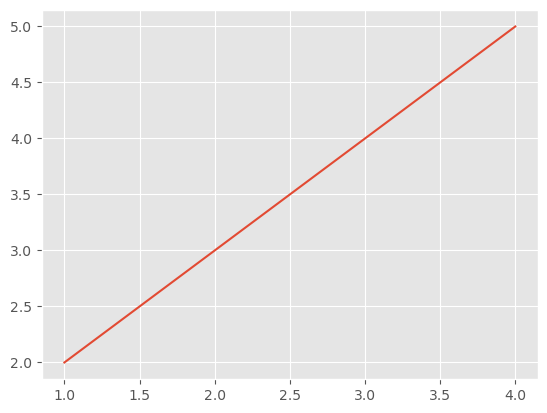
那么matplotlib究竟内置了那些样式供使用呢?总共以下26种丰富的样式可供选择。
print(plt.style.available)
[‘Solarize_Light2’, ‘_classic_test_patch’, ‘bmh’, ‘classic’, ‘dark_background’, ‘fast’, ‘fivethirtyeight’, ‘ggplot’, ‘grayscale’, ‘seaborn’, ‘seaborn-bright’, ‘seaborn-colorblind’, ‘seaborn-dark’, ‘seaborn-dark-palette’, ‘seaborn-darkgrid’, ‘seaborn-deep’, ‘seaborn-muted’, ‘seaborn-notebook’, ‘seaborn-paper’, ‘seaborn-pastel’, ‘seaborn-poster’, ‘seaborn-talk’, ‘seaborn-ticks’, ‘seaborn-white’, ‘seaborn-whitegrid’, ‘tableau-colorblind10’]
1.2 用户自定义stylesheet
在任意路径下创建一个后缀名为mplstyle的样式清单,编辑文件添加以下样式内容
axes.titlesize : 24 axes.labelsize : 20 lines.linewidth : 3 lines.markersize : 10 xtick.labelsize : 16 ytick.labelsize : 16
引用自定义stylesheet后观察图表变化。
plt.style.use('file/presentation.mplstyle')plt.plot([1,2,3,4],[2,3,4,5])plt.show()
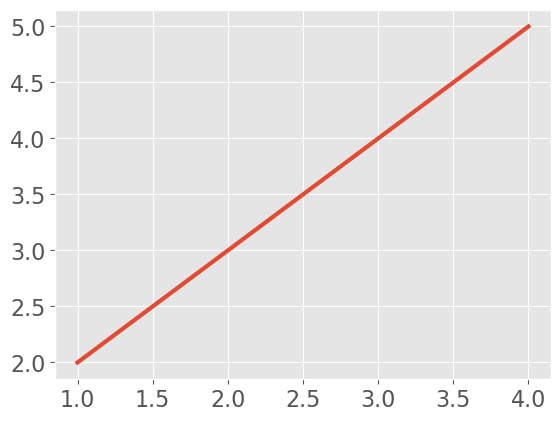
值得特别注意的是,matplotlib支持混合样式的引用,只需在引用时输入一个样式列表,若是几个样式中涉及到同一个参数,右边的样式表会覆盖左边的值。
plt.style.use(['dark_background', 'file/presentation.mplstyle'])plt.plot([1,2,3,4],[2,3,4,5])plt.show()
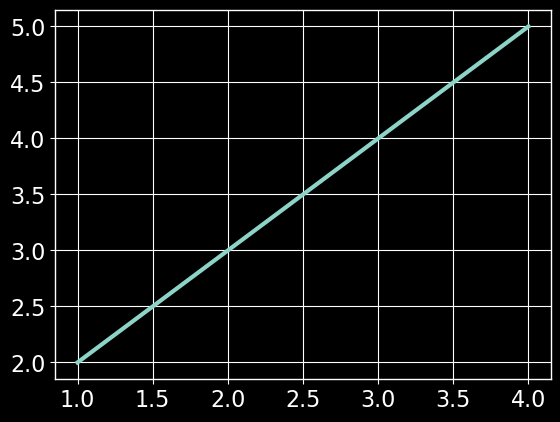
1.3 设置rcparams
我们还可以通过修改默认rc设置的方式改变样式,所有rc设置都保存在一个叫做 matplotlib.rcParams的变量中。
修改过后再绘图,可以看到绘图样式发生了变化。
plt.style.use('default') # 恢复到默认样式plt.plot([1,2,3,4],[2,3,4,5])plt.show()
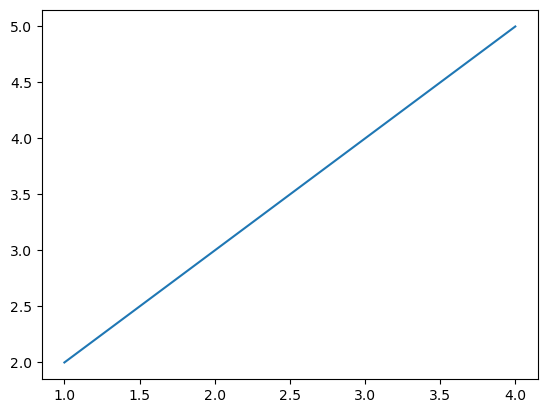
mpl.rcParams['lines.linewidth'] = 2mpl.rcParams['lines.linestyle'] = '--'plt.plot([1,2,3,4],[2,3,4,5])plt.show()
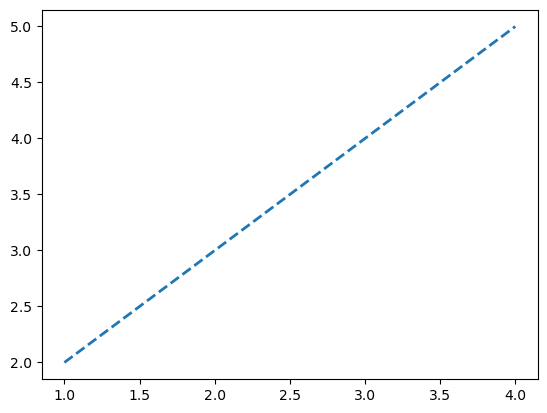
另外matplotlib也还提供了了一种更便捷的修改样式方式,可以一次性修改多个样式。
mpl.rc('lines', linewidth=4, linestyle='-.')plt.plot([1,2,3,4],[2,3,4,5])plt.show()
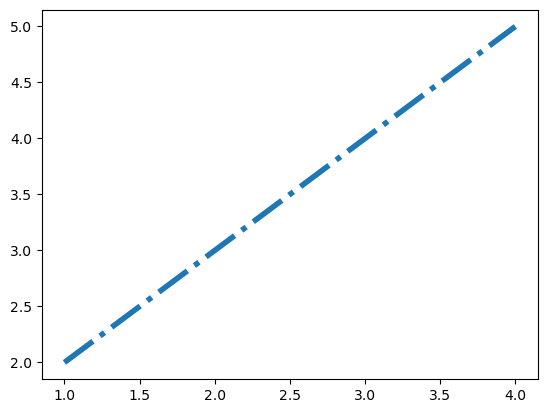
1.4 修改matplotlibrc文件
由于matplotlib是使用matplotlibrc文件来控制样式的,也就是上一节提到的“rc setting”,所以我们还可以通过修改matplotlibrc文件的方式改变样式。
# 查找matplotlibrc文件的路径mpl.matplotlib_fname()
‘c:\users\honk\appdata\local\programs\python\python37\lib\site-packages\matplotlib\mpl-data\matplotlibrc’
找到路径后,就可以直接编辑样式文件了,打开后看到的文件格式大致是这样的,文件中列举了所有的样式参数,找到想要修改的参数,比如lines.linewidth: 8,并将前面的注释符号去掉,此时再绘图发现样式以及生效了。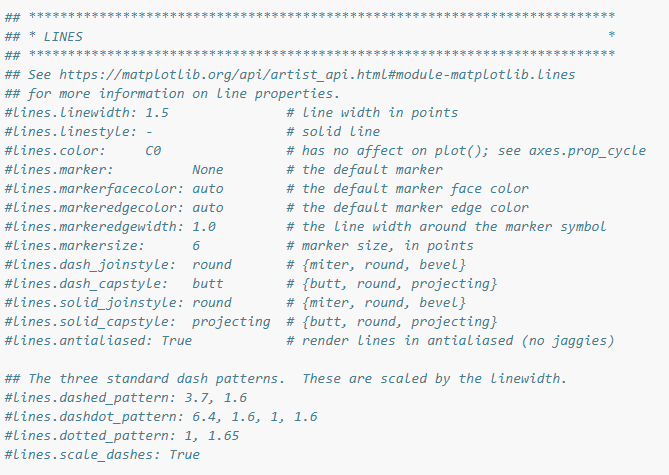
修改的文件和位置
修改之后的效果
( IPython Shell需要退出重新进一次才能生效,jupyter notebook则需要先shutdown后重新打开)
plt.plot([1,2,3,4],[2,3,4,5])plt.show()
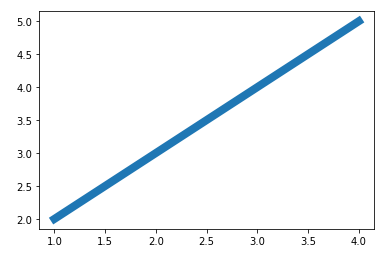
(想改回默认的话,就去把删掉的#号加回去吧(#^.^#))
(实测上面的方法无效,必须修改为默认值,比如把前面改过的那行,重新改为line.linewidth=1.5,重启一次,才能恢复到默认的设置。)
2. matplotlib的色彩设置(color)
在可视化中,如何选择合适的颜色和搭配组合也是需要仔细考虑的,色彩选择要能够反映出可视化图像的主旨。
从可视化编码的角度对颜色进行分析,可以将颜色分为色相、亮度和饱和度三个视觉通道。通常来说:色相: 没有明显的顺序性、一般不用来表达数据量的高低,而是用来表达数据列的类别。明度和饱和度: 在视觉上很容易区分出优先级的高低、被用作表达顺序或者表达数据量视觉通道。
具体关于色彩理论部分的知识,不属于本教程的重点,请参阅有关拓展材料学习。
ECharts数据可视化实验室
学会这6个可视化配色基本技巧,还原数据本身的意义
2.1 RGB或RGBA
plt.style.use('default')
# 颜色用[0,1]之间的浮点数表示,四个分量按顺序分别为(red, green, blue, alpha),其中alpha透明度可省略plt.plot([1,2,3],[4,5,6],color=(0.1, 0.2, 0.5))plt.plot([4,5,6],[1,2,3],color=(0.1, 0.2, 0.5, 0.5))plt.show()
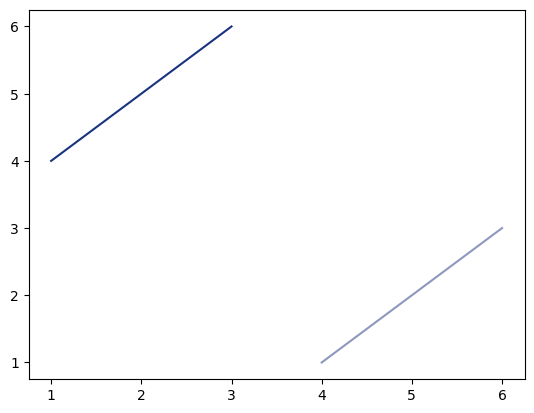
2.2 HEX RGB 或 RGBA
# 用十六进制颜色码表示,同样最后两位表示透明度,可省略plt.plot([1,2,3],[4,5,6],color='#0f0f0f')plt.plot([4,5,6],[1,2,3],color='#0f0f0f80')plt.show()
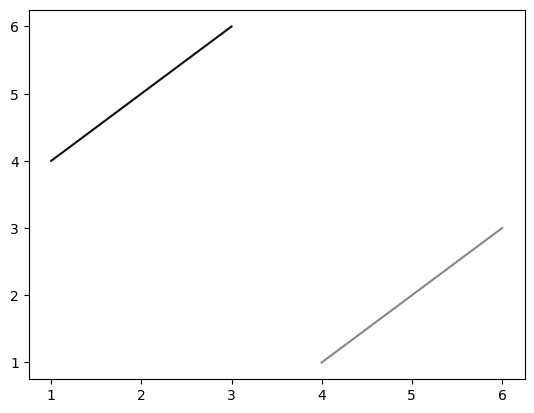
2.3 灰度色阶
# 当只有一个位于[0,1]的值时,表示灰度色阶plt.plot([1,2,3],[4,5,6],color='0.5')plt.show()

2.4 单字符基本颜色
# matplotlib有八个基本颜色,可以用单字符串来表示,分别是'b', 'g', 'r', 'c', 'm', 'y', 'k', 'w',对应的是blue, green, red, cyan, magenta, yellow, black, and white的英文缩写plt.plot([1,2,3],[4,5,6],color='m')plt.show()

2.5 颜色名称
# matplotlib提供了颜色对照表,可供查询颜色对应的名称plt.plot([1,2,3],[4,5,6],color='tan')plt.show()
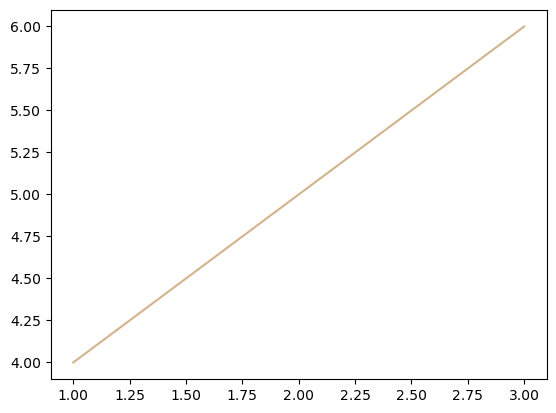

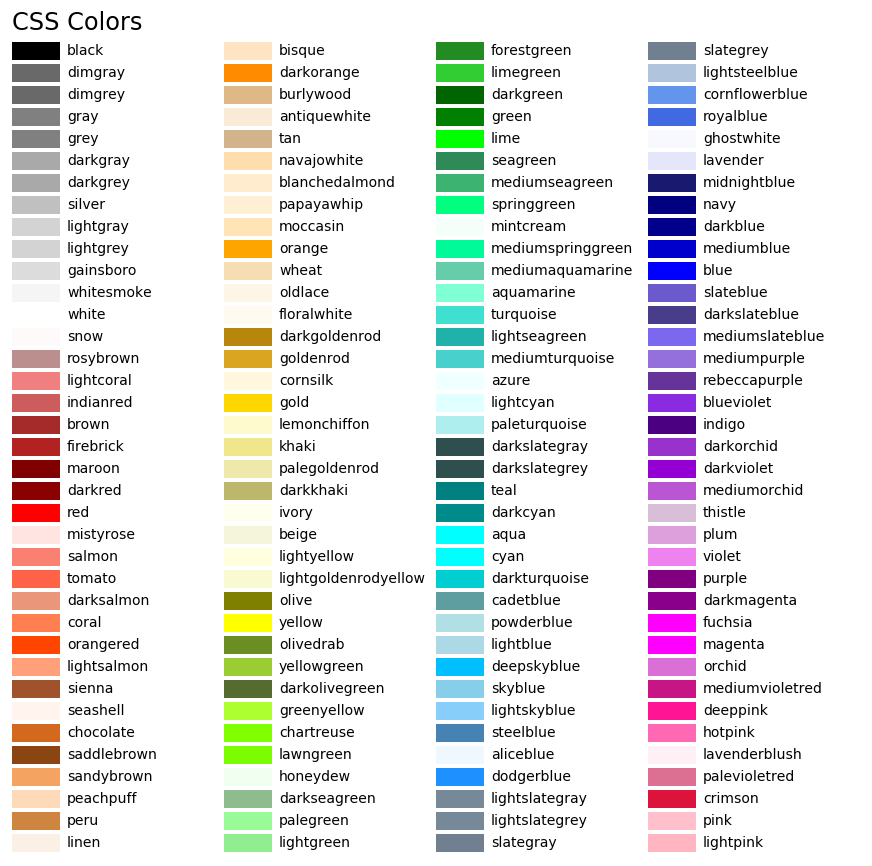
2.6 使用colormap设置一组颜色
有些图表支持使用colormap的方式配置一组颜色,从而在可视化中通过色彩的变化表达更多信息。
在matplotlib中,colormap共有五种类型:
- 顺序(Sequential)。通常使用单一色调,逐渐改变亮度和颜色渐渐增加,用于表示有顺序的信息;
- 发散(Diverging)。改变两种不同颜色的亮度和饱和度,这些颜色在中间以不饱和的颜色相遇;当绘制的信息具有关键中间值(例如地形)或数据偏离零时,应使用此值。
- 循环(Cyclic)。改变两种不同颜色的亮度,在中间和开始/结束时以不饱和的颜色相遇。用于在端点处环绕的值,例如相角,风向或一天中的时间。
- 定性(Qualitative)。常是杂色,用来表示没有排序或关系的信息。
- 杂色(Miscellaneous)。一些在特定场景使用的杂色组合,如彩虹,海洋,地形等。
x = np.random.randn(50)
y = np.random.randn(50)
plt.scatter(x,y,c=x,cmap='RdPu')
plt.show()

3. 作业
3.1 自定义colormap的形式
查阅matplotlib官网,列举出Sequential,Diverging,Cyclic,Qualitative,Miscellaneous分别有哪些内置的colormap,并以代码绘图的形式展现出来。
回答:
参考资料:
- https://matplotlib.org/tutorials/colors/colormaps.html
- https://matplotlib.org/gallery/color/colormap_reference.html?highlight=sequential
cmaps = [('Sequential', [
'Greys', 'Purples', 'Blues', 'Greens', 'Oranges', 'Reds',
'YlOrBr', 'YlOrRd', 'OrRd', 'PuRd', 'RdPu', 'BuPu',
'GnBu', 'PuBu', 'YlGnBu', 'PuBuGn', 'BuGn', 'YlGn']),
('Sequential (2)', [
'binary', 'gist_yarg', 'gist_gray', 'gray', 'bone', 'pink',
'spring', 'summer', 'autumn', 'winter', 'cool', 'Wistia',
'hot', 'afmhot', 'gist_heat', 'copper']),
('Diverging', [
'PiYG', 'PRGn', 'BrBG', 'PuOr', 'RdGy', 'RdBu',
'RdYlBu', 'RdYlGn', 'Spectral', 'coolwarm', 'bwr', 'seismic']),
('Cyclic', ['twilight', 'twilight_shifted', 'hsv']),
('Qualitative', [
'Pastel1', 'Pastel2', 'Paired', 'Accent',
'Dark2', 'Set1', 'Set2', 'Set3',
'tab10', 'tab20', 'tab20b', 'tab20c']),
('Miscellaneous', [
'flag', 'prism', 'ocean', 'gist_earth', 'terrain', 'gist_stern',
'gnuplot', 'gnuplot2', 'CMRmap', 'cubehelix', 'brg',
'gist_rainbow', 'rainbow', 'jet', 'turbo', 'nipy_spectral',
'gist_ncar'])]
gradient = np.linspace(0, 1, 256)
gradient = np.vstack((gradient, gradient))
def plot_color_gradients(cmap_category, cmap_list):
# Create figure and adjust figure height to number of colormaps
nrows = len(cmap_list)
figh = 0.35 + 0.15 + (nrows + (nrows-1)*0.1)*0.22
fig, axs = plt.subplots(nrows=nrows, figsize=(6.4, figh))
fig.subplots_adjust(top=1-.35/figh, bottom=.15/figh, left=0.2, right=0.99)
axs[0].set_title(cmap_category + ' colormaps', fontsize=14)
for ax, name in zip(axs, cmap_list):
ax.imshow(gradient, aspect='auto', cmap=plt.get_cmap(name))
ax.text(-.01, .5, name, va='center', ha='right', fontsize=10,
transform=ax.transAxes)
# Turn off *all* ticks & spines, not just the ones with colormaps.
for ax in axs:
ax.set_axis_off()
for cmap_category, cmap_list in cmaps:
plot_color_gradients(cmap_category, cmap_list)
plt.show()
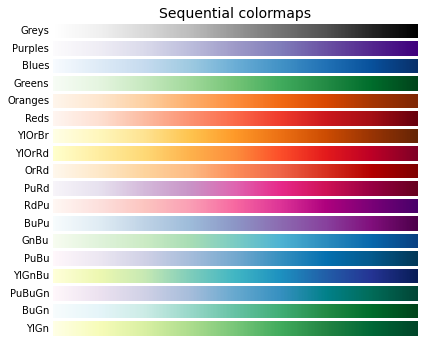
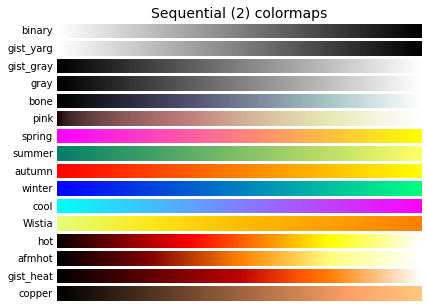
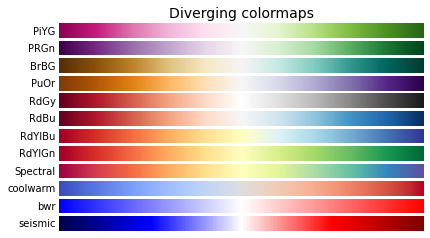

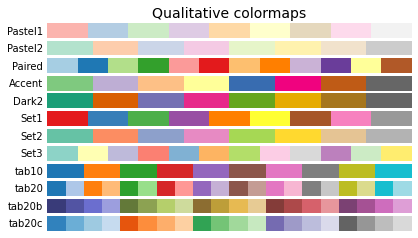

3.2 自定义colormap
学习如何自定义colormap,并将其应用到任意一个数据集中,绘制一幅图像,注意colormap的类型要和数据集的特性相匹配,并做简单解释。
回答:
正态分布的随机数模拟噪声数据。
x = np.random.randn(3000)
y = np.random.randn(3000)
z = np.random.randint(1, 10, size=3000)
c = np.random.randint(10, 50, size=3000)
plt.figure(figsize=(8,8))
plt.style.use('seaborn-dark')
for i in range(100):
plt.plot(x[i], y[i], marker='s', markersize=z[i], color='#0f0f0f'+str(c[i]))
plt.xticks([])
plt.yticks([])
plt.show()
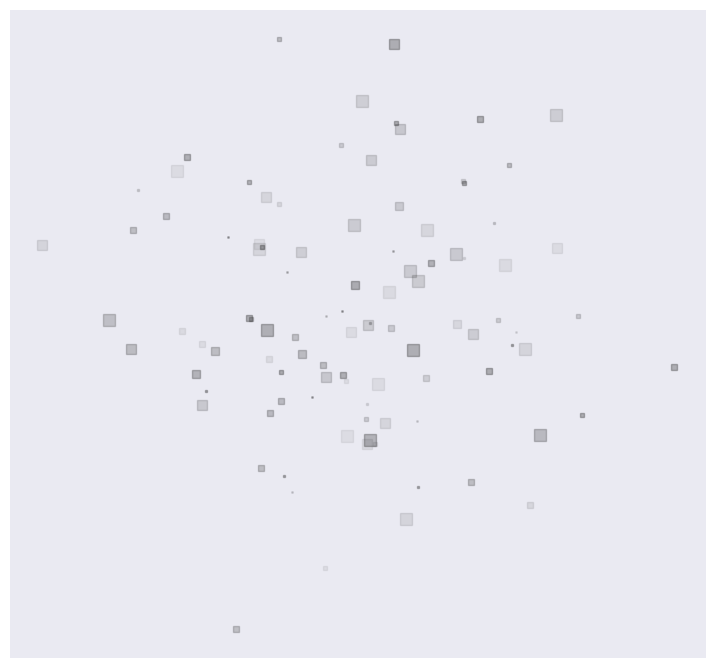
meaning lost.

